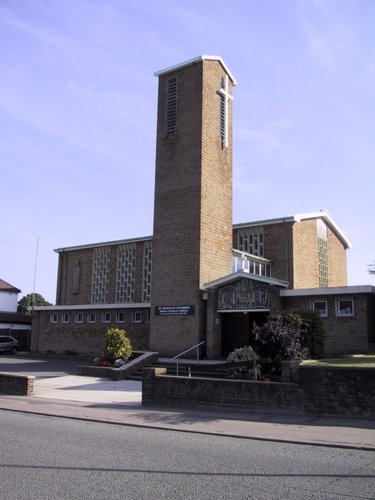The Quest for a Catholic Church in Rainham
Four centuries after Henry VIII’s break with Rome and nearly 40 years of hard work and organisation during the first half of the 20th century, the dream of a Catholic church eventually became reality for the Rainham Catholic community in 1958.
During the 1920s services were held at the Rainham Brotherhood Hall situated in Church Lane close to St Margaret’s church in Rainham High Street. An estimated congregation of about 50 people regularly attended Sunday morning Mass. The rent cost about 15p a week and Father Gerald Quinn, assistant priest at Gillingham Catholic Church organised everything, but the Rainham Catholic community were keen to move away and have a hall of their own.
The first stage of getting a permanent and suitable base began when the Diocesan Trustees bought a plot of land on a site adjacent to the London Road, the old medieval pilgrimage route from London to Canterbury for £270 with help from the parish of Gillingham in 1921.
When presiding Rainham priest Father McMahon retired communication between Father Gerald Quinn from Gillingham and the church authorities led to permission eventually being given for the building of a parochial hall on the new site. On August 2nd 1933 the hall with a capacity for 160 people became reality. The building served as a temporary church. Bishop Amigo opened it on November 10th 1934.
The Catholic community immediately set to work organising fund raising events through a newly elected social committee. Although weekly collections were only £1, whist drives were held and raffles took place while coach trips were arranged to the coast and other local locations during the summer months to raise funds for the new church.
By 1951 congregations had risen to 237 and a new fund raising scheme was introduced for finances to build a new church. To raise money a Catholic football pool and a Mile of Pennies scheme were set up. Such were the efforts that £158 8s 0d had been raised by October 1953.
On November 14th 1954 the parishes of Rainham and Gillingham held a social event to help boost funds to build a new church and school in Rainham. On the same evening a final decision was made to go ahead with the building of a church. A social club and a youth club were formed about the same time.
Dances held in the parochial hall proved to be a great success attracting people from far and wide. Bricks were sold for the new church at about 15p each after Sunday Masses. Rainham members of the Medway Catholic Women’s Guild made vestments for the new church and took it so seriously that they attended a course at the Medway College of Art in Rochester to ensure that they provided a high quality product.
Eduardo Dodds became the architect entrusted with designing the new church then on April 21st 1956 tenders for the building were revealed. Of seven local companies J H Durrant of Strood had their tender accepted and construction got underway in the Autumn of 1956 when the foundations of the church were dug and the brickwork begun. Although a crisis regarding finances arose at one stage a solution was eventually found and the building, dedicated to St Thomas of Canterbury, continued and became the only Catholic church to be constructed in the diocese at that time. With all the trials and tribulations involved in the construction with regard to finances, the ‘Laying of the Foundation Stone’ took place with Bishop Cyril Cowderoy directing the proceedings on December 29th 1956.
The new church had an interesting design in the modern idiom with beautiful carvings and statuary completed by Michael Clark FRBS who became President of the Royal Academy of Art. The church also acquired his ‘14 Stations of the Cross’ and the canonical erection of this took place on November 19th 1958. A statue of St Thomas of Canterbury, a gift presented to the church by Father Scott, was placed in front of the organ where it could be seen by members of the congregation leaving the church.
The church ceramics were designed by Adam Kossowski. These included a figure of St Joseph seated with the child Jesus. In the Lady Chapel angels were set against a background of blue tiles. A colourful depiction of the murder of St Thomas of Canterbury above the main entrance of the church is unique although Reverend Trew of Upchurch wrote in his short history of Upchurch church in 1911 that a fresco of St Thomas of Canterbury existed on the wall of the Lady Chapel of Upchurch church until it was whitewashed over after repairs.
The official opening of St Thomas of Canterbury Church took place on April 28th 1958 although the consecration of the building did not happen until June 11th 1970. A decision had been made to pay off all the debts for the building before the event could took place.

Photo of St Thomas of Canterbury Catholic Church, Rainham, Kent
Father Swinton continued as the parish priest and he remained until 1961. He lived nearby in Salisbury Road. Father Petry succeeded him and stayed until 1963 then Father Gleeson arrived and served the parish for ten years.
Now a familiar and distinct landmark on the main road to Gillingham, St Thomas of Canterbury church continues to attract new members to its congregation and remains an important location in the parish. It also maintains a close connection with St Thomas of Canterbury Primary School in Romany Road and St John Fisher Catholic School in Chatham.










































































































































